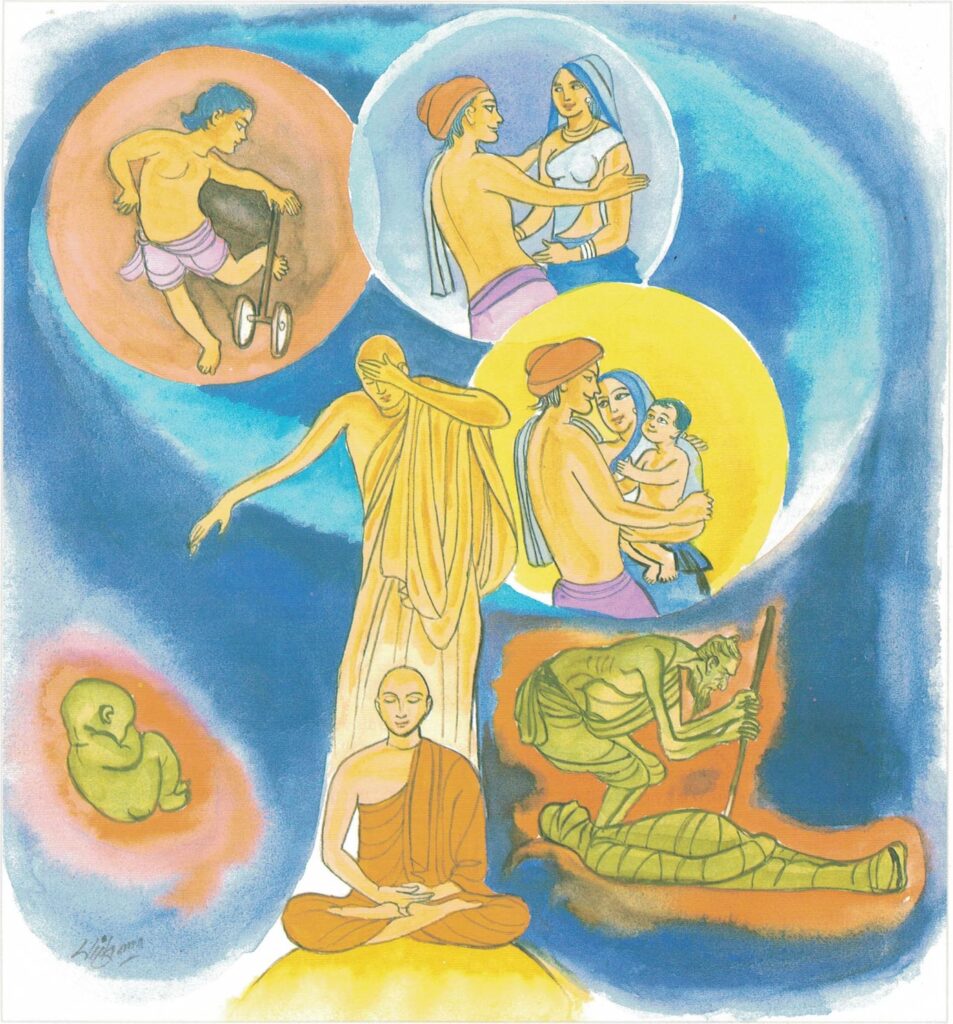Pali text, illustration and English translation of Dhammapada verse 348:
muñca pure muñca pacchato majjhe muñca bhavassa pāragū |
sabbattha vimuttamānaso na puna jātijaraṃ upehisi || 348 ||
348. Let go before, let go the after, let go the middle, beyond becoming. With mind released in every way you’ll come no more to birth, decay.

The Story of Uggasena
While residing at the Jetavana Monastery, the Buddha spoke this verse, with reference to Uggasena, a rich man’s son who fell in love with a dancer.
Once, a wandering theatrical troupe consisting of five hundred dancers and some acrobats, came to Rājagaha and performed in the grounds of the palace of King Bimbisāra for seven days. There, a young dancer who was the daughter of an acrobat, sang and danced on top of a long bamboo pole. Uggasena, the young son of a rich man, fell desperately in love with this dancer and his parents could not stop him from marrying her. He married the young dancer and followed the troupe. As he was not a dancer nor an acrobat, he was not of much use to the party. So, as the party moved from place to place, he had to carry boxes, to drive the carts, etc.
In course of time, a son was born to Uggasīna and his wife, the dancer. To this child, the dancer would often sing a song which ran thus “O you, son of the man who keeps watch over the carts; the man who carries boxes and bundles! O you, son of the ignorant one who can do nothing!” Uggasena heard the song; he knew that his wife was referring to him and he was very much hurt and depressed. So he went to his father-in-law, the acrobat, and requested him to teach him acrobatics. After a year’s training, Uggasena became a skilful acrobat.
Then, Uggasena went back to Rājagaha, and it was proclaimed that Uggasīna would publicly demonstrate his skill in seven days’ time. On the seventh day, a long pole was put up and Uggasena stood on top of it. At a signal given him from below he somersaulted seven times on the pole. At about this time, the Buddha saw Uggasena in his vision and knew that time was ripe for Uggasena to attain arahatship. So he entered Rājagaha and willed that the audience should turn their attention to him instead of applauding Uggasena for his acrobatic feats. When Uggasena saw that he was being neglected and ignored, he just sat on top of the pole, feeling very discontented and depressed. The Buddha then addressed Uggasena, “Uggasena, a wise man should abandon all attachment to the khandha aggregates and strive to gain liberation from the round of rebirths.”
Explanatory Translation (Verse 348)
pure muñca pacchato muñca majjhe muñca bhavassa pāragū
sabbattha vimuttamānaso na puna jātijaraṃ na upehisi
pure: craving for the past physical forms; muñca: give up; free yourself from;pacchato [pacchata]: craving for future physical forms; majjhe: craving for the present physical forms; bhavassa: of existence; pāragū: you have come to the end (you have gone to the other shore); sabbattha: everywhere; in everything; vimuttamānaso [vimuttamānasa]: (you are) of non-attached mind; puna: once again; jātijaraṃ [jātijara]: to birth and death; na upehisi: you will not come
Give up the past, give up the future, give up the present. Having reached the end of existences, with a mind freed from all (conditioned things), you will not again undergo birth and decay.
At the end of the discourse, Uggasena, who was still on top of the pole, attained arahatship. He came down and was soon admitted to the Sangha by the Buddha.
Commentary and exegetical material (Verse 348)
bhavassa pāragū: having come to the end of existence–bhava. Bhava: becoming, process of existence, consists of three planes: sensuous existence (kāma-bhava), fine-material existence (rūpabhava), immaterial existence (arūpa-bhava).
The whole process of existence may be divided into two aspects:
(1) kamma-process (kamma-bhava), that is, the kammically active side of existence, being the cause of rebirth and consisting in wholesome and unwholesome volitional actions.
(2) kamma-produced rebirth or regenerating process (uppattibhava), that is the kammically passive side of existence consisting in the arising and developing of the kamma-produced and, therefore, morally neutral mental and bodily phenomena of existence.